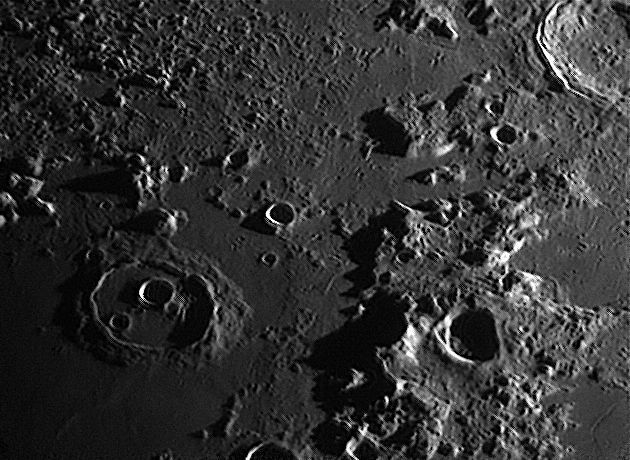

Move your mouse over the picture to see the names of the various craters. Cassini is 57-km crater formed after the Imbrium basin but before that was flooded with lavas which puts it between 3,800 and 3,850 million years old. The mare lavas swept around Cassini leaving it appearing to stand on a skirt of rough rocks. This sloping terrain surrounding the crater is actually typical of craters of this size and is caused by the rocks being pushed outwards by the impact that caused the crater and by ejecta falling back onto the surrounding area. In this case, lavas also rose within the crater filling it to within a kilometre of the rim and probably covering any central mountain that may have formed initially. Later, probably much later, two smaller craters, Cassini A and Cassini B, were formed within Cassini, the former at least leaving further debris around it, particularly to the east.

This picture was taken when the Sun was at an elevation of only about 4° above the eastern horizon on the Moon, so it shows considerable detail. The skirt surrounding Cassini is particularly evident. There are many mountains in this area but I have been unable to find names for any of them. The rough terrain in the north-west of this picture (upper-left) lies behind the Lunar Alps and probably represents boulders and general debris thrown out by the impact that formed the Imbrium basin. The mountains to the east of Cassini are the Caucasus mountains
Particularly interesting in this picture is Calippus which looks D-shaped and as such is not unlike the appearance of Eimmart in some lighting conditions. However, in this case, the crater really does seem to have a straight eastern wall.
The scale markers are approximately 50 Km north and east.
The picture was taken with a DMK camera attached to my LX200 on 10th April 2011 at 20:23 UT,
when the Moon was 6.7 days old.
Lunar Phase: 97.9°
Colongitude: 359.7°
Date and Time: 10th April 2011 20:29 UT
Camera: DMK 21AF04
Telescope: LX200 with X2 lens and commercial IR-pass filter
Capture: ICCapture. Gamma 10, 1/77", gain 1023, 3485 frames
Processing: Registax6. 21 alignment points, 110 frames stacked. Gaussian wavelet 1 (0.1, 0.07) = 100, wavelet 2 (0.15, 0.1) = 100, wavelet 3 (0.44, 0.1) = 100
Focus Magic 4,100 Home Back to NE Quadrant